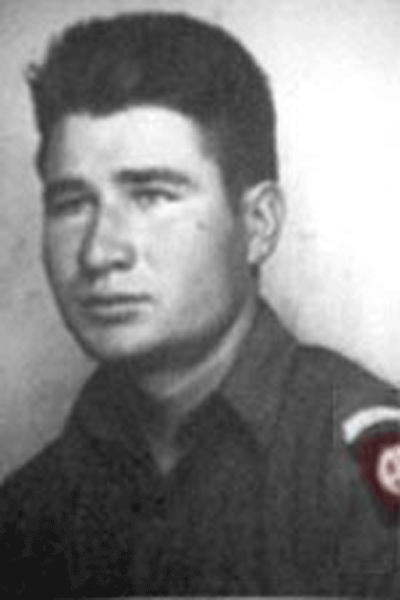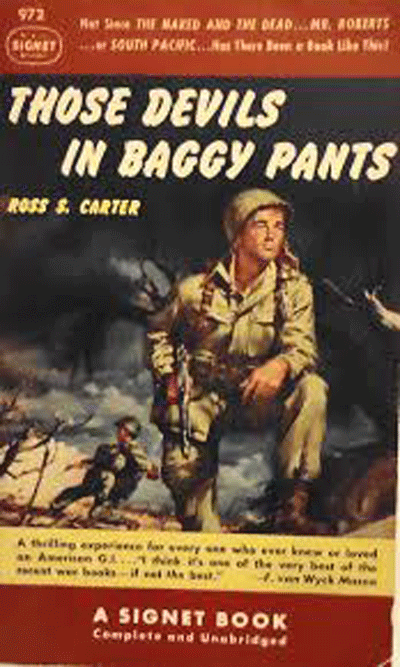PFC. THOMAS L [LLOYD] RODGERS WWII VETERAN
Published 10:27 am Monday, October 21, 2019
|
Getting your Trinity Audio player ready...
|
The following note was found in the diary of a German officer who fought
against the US 504 th Parachute Infantry Regiment at Anzio:
“American parachutists – devils in baggy pants – are less than one hundred meters
From my outpost line. I can’t sleep at night. They pop up from nowhere and
we never know when or how they strike next. Seems like the black-hearted
devils are everywhere……”
Not many veterans have a whole chapter of a book devoted to their actions in WW II. If that’s
not enough, the book was made into a movie, “Those Devils in Baggy Pants”, by Ross S Carter.
Pfc. Thomas L Rodgers, from the Carolina community in Covington county, was a soldier taking
part in the Normandy invasion on June 6, 1944. Rodgers was killed after parachuting into
Belgium near the town of St. Mere Eglise. This story is about the heroic actions of “Big Rodgers”
, the affectionate nickname given Thomas L Rodgers by his fellow paratroopers in “C” Company
[1 st Battalion] of the 504 th Parachute Infantry Regiment of the legendary 82 nd Airborne Division.
The story of “Big Rodgers” began April 5, 1921, when Mr. and Mrs. Evans Rodgers of the
Carolina community became the parents of a son that they named Thomas L Rodgers. Lloyd, as
he was called, grew up in the area and attended Pleasant Home School. He was a star
basketball player, and later on in the service, would become a Golden Gloves boxing champion.
He was called into service on Nov 25, 1940 when he joined the Alabama National Guard. Like so
many others of the 117 th Field Artillery unit in Andalusia, Al., Lloyd trained at Camp Blanding in
Florida and took part in maneuvers at Camp Bowie, Tx. After that, Rodgers was selected for
Airborne training at Ft. Benning, Ga. He did advanced training at Ft. Bragg, NC. and upon
completion, received his parachute wings and was assigned to Company “C” of the 504 th
Parachute Regiment.
The 504 th was sent to the Mediterranean theater to take part in the invasion of Sicily in 1943.
Rodgers’ first jump would take place over Sicily. One of his fellow paratroopers remembered
Lloyd reading from his pocket Bible right before the jump.
As the 504 th continued with the Army’s invasion of the Italian mainland, Rodgers would make
night jumps at Salerno, Cassino and Anzio, usually behind the lines. Rodgers and his fellow
troopers continued fighting up through the mountainous regions of Italy to the north.
At some point after months of fighting the retreating Germans, the 504 th was sent to England
for rest. The rumors were going around about a future invasion of Europe.
A call was sent out for volunteers among the paratroopers. One of Rodgers fellow troopers,
David R Berry said this, “Thomas L Rodgers was an exceptional soldier. In an Army where the
phrase ‘Never volunteer for anything’ was common, he seemed to volunteer for everything”.
Lloyd Rodgers and 24 of his fellow paratroopers volunteered. Ross S Carter, the author of the
book mentioned above and one of Rodgers comrades said, “We gravely shook hands, a gnawing
anxiety in our gizzards. ‘Big Rodgers’ was a staunch pillar of our platoon, both morally and
physically. When on outpost duty with him, I always had the feeling that things were well in
hand”.
Rodgers and his fellow volunteers were placed into a Pathfinder unit that would supply security
for the 507 th and 508 th regiments that were to be dropped behind the lines on D Day.
At 0100 on the morning of June 6, 1944, Rodgers and the other Pathfinders were dropped
behind the German lines, inland from Normandy. Through some unfortunate timing error, they
were dropped right on top of a German garrison, holed up in a farm house. Rodgers managed
to escape for a short time but eventually found himself in a terrible fight.
There are different dates give as to Lloyd Rodgers death. Some account say it was on D Day,
June 6. Other accounts list June 18. The important thing is “what happened before Rodgers
died”. His actions during that time made him a legend among the Pathfinders and the 82 nd
Airborne.
When Rodgers jumped, he carried with him, a sawed off Browning Automatic Rifle, or BAR as it
was called. Quoting from Ross Carter in his book, “Those Devils in Baggy Pants” : in the battle
near St. Mere Eglise, “Big Rodgers” killed 40 Germans with a sawed off BAR before he went
west”.
Again quoting Ross Carter, “Before Big Rodgers left us in England for his jump, I told him, Be
careful T. L. He hesitating as was his custom before answering : ‘I’ll be as careful as I can, Ross,
but I may not be careful enough this time’. Then he left. That evening we drank several bottles
of ale and we toasted Big Rodgers on every bottle.”
Carter continued, “I feared the worst for Big Rodgers and our other buddies. My fears were
justified. Of the 25 who volunteered, 17 were killed including Big Rodgers.”
For his heroic actions in battle, Thomas Lloyd Rodgers was awarded our nations’ second honor,
The Distinguished Service Cross. The citation reads:
CITATION FOR THE DISTINGUISHED SERVICE CROSS [Posthumous]
Private First Class THOMAS L RODGERS, 20421704, Infantry, United States Army
For extraordinary heroism in connection with military operations against an enemy
of the United States. Having jumped into Normandy in the vicinity of AMFREVILLE,
FRANCE on June 6, 1944, Private First Class Rodgers, observing many of his comrades
pinned down by enemy machine gun and small arms fire, moved without hesitation
to destroy the enemy. Mounting a stone wall, in full view of the enemy, he neutralized
the machine gun position and proceeded forward, driving back the enemy with effective
fire from his Browning Automatic Rifle. During this action, Private First Class Rodgers
killed or wounded 25 of the enemy and made possible the organization and advance
of our troops in the area. His personal courage, aggressive leadership and courageous
inspiration contributed materially to the success of his comrades and typified the highest
traditions of the service. Private First Class Rodgers was later killed in action against the
enemy. Entered military service from Alabama.
Quoting further from Carter’s book, “The news of T L’s passing rolled gloom throughout the
platoon thicker than London fog. At the same time, we felt the elevation of spirit that comes
with the confirmation of trust well placed. The giant had given a good account of himself.”
And later, “After Big Rodgers’ death, a package arrived from his mother. Among its contents
were several pairs of fine woolen socks. We distributed them among us and reserved them to
wear only in battle. When we wore the socks, we had the feeling that Big Rodgers was with us
in body as well as in spirit and could participate personally in his revenge.”
The legend of Rodgers’ socks continued throughout every battle fought by the 504 th . In time
they became a good luck omen, with the belief that anyone wearing those socks would return
safely from battle.
Rodgers was also awarded the Bronze Star for his actions. The family of Rodgers was
devastated by his loss. Making matters worse, the family also had three other sons serving in
the Navy throughout the remainder of the war. They were John Thomas Evans Jr., Kenneth and
Burton.
Lloyd Rodgers was temporarily buried in France, but eventually the family was able to have his
body returned home and he was buried at the Carolina Baptist Church Cemetery.
In addition to the Distinguished Service Cross, Rodgers was awarded a Bronze Star and the
Purple Heart.
-John Vick
[Author’s note: sources used for this article include: “Those Devils in Baggy Pants” by Ross S
Carter; The Andalusia Star News [1951]; article in the Star News by Curtis Thomasson; the US
military archives and Jim and Sherry Garner. Sherry is the niece of Pfc. Lloyd Rodgers]







